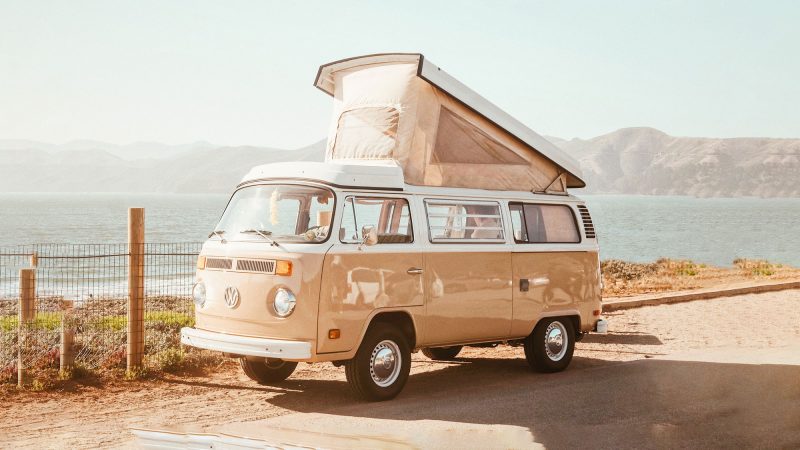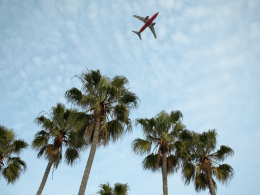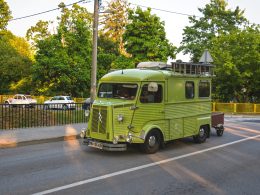Ready for a trip down memory lane? Let’s look back at what RVing was like in the 1970s when cars and not heavy-duty trucks towed most travel trailers.
The actual experience was pretty similar. Not much has changed — a checkered tablecloth on a picnic table, a family gathered around a campfire. But wow, have the RVs changed!

How Did the Gas Crisis of the 1970s Affect the RV Industry?
In October of 1973, OAPEC (Organization of Arab Petroleum Exporting Countries) declared an oil embargo on the United States. As a result, gas stations closed on Sundays, and long lines became the new normal. Gas shortages were common. This lasted about six months into March of 1974.
Although these few months hit during the camping off-season, the recovery time lasted much longer. Thus, many campers chose to forego camping all together in 1974. Others only took short weekend trips. Most canceled any long, cross-country travel plans. People were still concerned and apprehensive.
After this crisis, the RV industry saw a shift toward lightweight travel trailers that campers could pull with standard vehicles like Hondas and Toyotas because there was also a shift in the car industry. A rejuvenation of pop-up campers ensued.
The Boler travel trailer also became popular since it was the first all-fiberglass option. It was only 800 lbs but much stronger than the other RVs on the road during that time. Because people were interested in fuel-saving automobiles, the RV industry had to follow suit.
New RV Tech: What Innovations Came Out in the ‘70s?
The Oldsmobile Toronado had a 17.9-ft chassis, which grabbed the attention of a few manufacturers in the RV industry. They adapted the chassis to fit a Class A motorhome.
However, by 1978, GM was the only manufacturer using the chassis. John Hall, the creator of Revcon, made a deal with GM to use the Toronado chassis. Although his adaptation worked perfectly, sales dried up, and Revcon closed down. GM continued to use his modifications in their own motorhomes.
The Food Machinery Corporation (FMC) tried its hand in the RV industry. Although it was short-lived, it produced a luxurious Class A motorhome. Details such as carpet-lined interior cabinets made FMC motorhomes the Newmar of the day.

Carol Burnett, Clint Eastwood, and Mario Andretti owned these luxury RVs. But in 1976, production stopped to focus on other endeavors.
Finally, L.K. Newell changed the RV industry by introducing the diesel pusher. This rear-engine concept could move more weight and provide a smoother ride than other motorhomes. Looking back, he was years ahead of other manufacturers.
Popular RV Models in the 1970s
The Airstream Argosy was manufactured only during the years 1974-1979. It was a more affordable version made with a lower-grade aluminum that was then painted.
Winnebago started in the late 1960s and saw its popularity soar to challenge Airstream’s dominance during the 1970s. Another popular model in the 1970s was the Shasta travel trailer. These models were less expensive but still retained high quality.
The Volkswagen camper van and the Chrysler Sportsman camper van were also popular in the 1970s. The pop-up tent on the roof provided room to eat, sleep, and travel.
Finally, GMC’s Dodge Travco motorhome became popular with its sleek, fiberglass shell. It introduced cruise control and air conditioning to travelers.
How Much Did a New RV Cost in the 1970s?
This varied as much as RV prices do today. You can buy a 2022 Grand Design Solitude 280RK for around $114,000 or a 2022 Classic Airstream for around $179,000. Prices are as varied as the floorplans and manufacturers.
In the 1970s, you could buy a Boler compact travel trailer for $1,500 while its competitors priced theirs around $900. Winnebago’s D-18 Brave motorhome cost just under $7,000. Other versions of Winnebago motorhomes sold for around $14,500.
RV Campsites: What You Could Expect
The actual campsite experience was pretty much the same as it is today. Families enjoyed being out in nature, cooking over a campfire, and spending time together. Of course, kids and teens didn’t have an iPhone or Nintendo Switch in their hands during this time. But generally, camping wasn’t much different in the 1970s.

What Were the Popular Camping Accessories in the 1970s?
As mentioned above, the camping experience wasn’t much different. With less technology and fewer gadgets, most campers just enjoyed swimming outdoors at the beach or hiking in the mountains. Outdoor cooking was popular because most RVs didn’t come with kitchens, so folks had to bring along accessories such as campfire skillets.
Then and Now
The RV industry saw huge changes in motorhome production in the 1970s. But many campers still enjoyed their truck campers, van and bus campers, and pop-up campers.
Camping was still reserved for vacations and weekend excursions. The idea of full-time RV living wasn’t really possible yet. But as the RV industry continued to improve over the next few decades, more and more people would hit the road.
Do you remember the 1970s? Do you remember seeing the Volkswagen bus pop-up roofs or Winnebago RVs driving down the road?
If You Want the Latest Travel News, Join Our Mailing List
Don’t rely on biased RV industry news sources to keep you informed. Stick with Nomadic News. We publish articles and breaking stories that matter to you every weekday.










